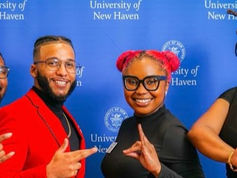50 Years Since a Forgotten Genocide
- horseshoemag
- Apr 25
- 4 min read
Updated: Apr 26

Contributing Writer
Azam Hostetler
Hate is a powerfully destructive tool. Covering up the nightmarish past is another.
April 17, 1975. Tanks emerge on the streets of the capital city, Phnom Penh. Cambodia is about to come to the end of a brutal five-year civil war amid decades of political turmoil. The United States-backed Khmer Republic government had been defeated, and the U.S. Embassy and other officials had been evacuated just five days earlier. Yet about five decades ago, among the mass refugees and cheering crowds, their hopeful allure of peace was struck down.
In just four years, at least 1.25 million — though it’s possible as many as 3 million — Cambodians perished from disease, starvation and mass murder. Civil and property rights were abolished, along with the expression or practice of religion. Society was to be remade in accordance with communist beliefs to create a “new Angkorian” empire. All evidence of Western and pre-revolutionary influence was eradicated. According to Britannica, anyone speaking different languages, holding jobs considered “intellectual,” or belonging to minority ethnic or religious groups was especially targeted.
At the helm of the Khmer Rouge was leader and Prime Minister Pol Pot, who renamed the country Democratic Kampuchea and instituted the concept of Year Zero. All of Cambodia’s rich history was to be erased. The identities of the population were reset, and a form of Maoist communism aimed at building a classless society was implemented. According to the Holocaust Memorial Day Trust, the ideology cast educated city dwellers and Western capitalist ideals as corrupt, promoting a regime ruled by and for the poorest peasants.
The world’s attention was drawn to the humanitarian crisis by the 1984 film The Killing Fields. Haing S. Ngor portrays a survivor, based on real-life journalist Dith Pran, who is forced to march out of deserted cities and work in forced labor on hopeless agricultural projects. Starving and severely beaten, his character treks through mud-filled trenches scattered with rotting skulls and skeletons, eats lizards to survive, and witnesses daily executions of those who disobey. These are only fragments of the horrors millions endured.
The film also depicts the fall of the American Embassy through the eyes of a U.S. journalist, the devastation caused by American bombings during the civil war, and the growing political tensions that led to the 1975 takeover. Many Americans might not know where Cambodia is on a map or might conflate this tragedy with the Vietnam War. But the Cambodian genocide was a distinct catastrophe that warrants recognition — because it should have never happened.
Radios, music, currency, hospitals and factories were banned or rendered obsolete. All children age 8 and older were separated from their parents, and formal education was abolished. The Khmer Rouge indoctrinated children to view the state as their true parent. According to the Holocaust Memorial Day Trust, children were seen as pliable and easily brainwashed. They were taught to obey and to believe that anyone who violated Pol Pot’s ideology — even for eating without permission — deserved execution.
The Khmer Rouge was overthrown in 1979 by a Vietnamese invasion, which installed a puppet government. In the decades since the genocide, Cambodia has largely been ruled by the Cambodian People’s Party, which has justified its grip on power by invoking the trauma of the past. As reported by The Conversation, most of the population was born after 1979, and education on the genocide remains limited, resulting in a national knowledge gap. History has been manipulated, trauma repressed, and authoritarianism reframed as stability.
Justice was delayed for decades, and many perpetrators of the genocide still walk free — some even hold government positions or live near survivors. Cambodia’s economy, heavily reliant on tourism and exports, has grown, but its intellectual class remains stunted due to the systemic destruction of human capital during the genocide. As The Conversation reports, intergenerational trauma persists, and discussions of the past are often neglected rather than embraced. The legacy of the genocide lingers in the institutions and in the system.
So why does this matter now? It’s been 50 years. But historical amnesia — the failure to understand how the past informs the present and future — is dangerous. Those who forget history may be doomed to repeat it. Political extremism in any form is dangerous, especially when it leads to bloodshed. The hatred instilled in children, in Khmer Rouge soldiers, in Pol Pot, and in all who participated in the genocide, shows how powerful and destructive that four-letter word — hate — can be. Violence is never the answer, nor is silence about the past.
The people of Cambodia deserve honest reflection, not suppression, forgetfulness or educational neglect. Many young people may not know their country’s history, yet they carry inherited trauma within their families. The killing fields — where victims were slaughtered with pickaxes because bullets were too costly, where children were trained to hate, where famine and disease ran rampant — must not be forgotten. We have a duty to remember these atrocities to prevent the next genocide. Across the globe, people have suffered and continue to suffer under extremism and oppression. And while many think, “It can’t happen here,” it can.
Dith Pran, the real-life journalist portrayed by Ngor in The Killing Fields, once said, “I don't consider myself a politician or a hero. I'm a messenger. If Cambodia is to survive, it needs many voices.” Many ears. Many eyes. Many voices. Looking back, 50 years later, at those tanks rolling into the cheering streets of Phnom Penh — tanks that brought not peace but devastation — we are left with a collective memory, and a collective responsibility, to never forget.
Azam will be joining Horseshoe Magazine as editor for Photojournalism during the Fall 2025













Comments